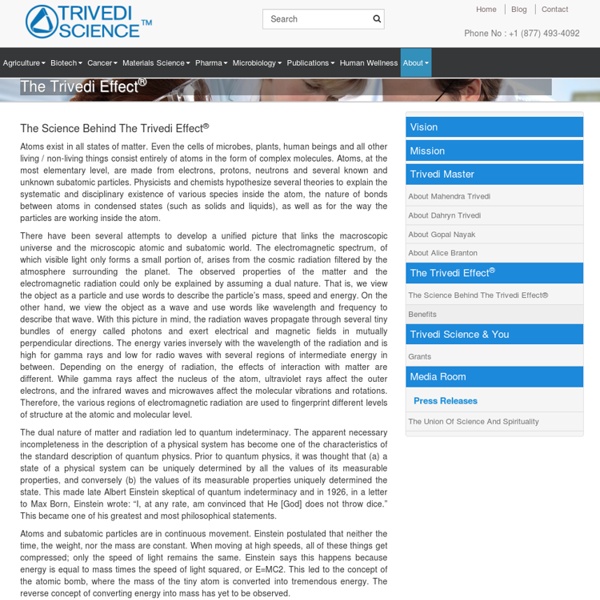Mahendra Kumar Trivedi
Mahendra Kumar Trivedi earned his 5-year Bachelor’s degree in Mechanical Engineering in 1985 . Mahendra Kumar Trivedi worked as an Engineer for 10 years. In 1995, Mr.
Impact of Human Biofield Energy on 1,2,3-Trimethoxybenzene
Abstract Study background: 1,2,3-Trimethoxybenzene is an important compound used for the synthesis of chemicals and pharmaceutical agents. The objective of this study was to investigate the influence of biofield energy treatment on the physical, thermal and spectral properties of 1,2,3-trimethoxybenzene. Methods: The study was performed by dividing the sample into two groups (control and treated). The control group remained as untreated, while the treated group received Mr Trivedi’s biofield energy treatment.
Antibiogram, Biochemical Reactions and Genotyping Characterization of Biofield Treated Staphylococcus aureus
Title: Antibiogram, Biochemical Reactions and Genotyping Characterization of Biofield Treated Staphylococcus aureus Publication: American Journal of BioScience Select license:
"An Effect of Biofield Treatment on Multidrug-resistant Burkholderia ce" by Mahendra Kumar Trivedi
Abstract Burkholderia cepacia (B. cepacia) is an opportunistic, Gram negative pathogen which causes infection mainly in immunocompromised population and associated with high rate of morbidity and mortality in cystic fibrosis patients. Aim of the present study was to analyze the impact of biofield treatment on multidrug resistant B. cepacia. Clinical sample of B. cepacia was divided into two groups i.e. control and biofield treated.
Characteristic of Shigella sonnei after Biofield Treatment
Abstract Shigella sonnei (S. sonnei) is a non-motile, rod shape, clinically significant, Gram-negative bacterium. It is commonly associated with dysentery (shigellosis). Recently, resistance to third and fourth generation cephalosporins and fluoroquinolones has been reported in S. sonnei. In the present study, we assessed the effect of biofield treatment on phenotyping and genotyping characteristic of S. sonnei (ATCC 9290).
Effect of Biofield Treatment on Boron Nitride
Abstract Boron nitride (BN) is known for high hardness, thermal stability, thermal conductivity, and catalytic action. The aim of this study was to investigate the effect of biofield treatment on physical, structural and spectral properties of BN powder. The control and treated sample of BN powder were characterized by X-ray diffraction (XRD), surface area analysis and Fourier transform infrared spectroscopy (FT-IR).
Impact of Biofield Treatment on Methyl-2-Naphthyl Ether
Abstract Methyl-2-naphthyl ether (MNE) is an organic compound and used as the primary moiety for the synthesis of several antimicrobial and anti-inflammatory agents. This study was attempted to evaluate the impact of biofield energy treatment on the physical, thermal, and spectroscopic properties of MNE. The study was carried out in two groups i.e., control and treated. The treated group was subjected to Mr. Trivedi’s biofield treatment.
Antibiogram, Biochemical Reactions and Genotyping Characterization of Biofield Treated Staphylococcus aureus
American Journal of BioScience 2015; 3(6): 212-220 213 health and healing [8]. B iofield en ergy treatment has been known as an alterna tive approach that may be useful to a lter the sensitivit y pattern of the antimicrobia ls. Harold Saxton
Phenotyping and 16S rDNA Analysis after Biofield Treatment on Citrobacter braakii: A Urinary Pathogen
Share this: Embed* Cite this: Trivedi, Mahendra Kumar (2015): Phenotyping and 16S rDNA Analysis after Biofield Treatment on Citrobacter braakii: A Urinary Pathogen. figshare. Retrieved 10:07, Dec 08, 2015 (GMT)
Evaluation & Characteristic of Shigella sonnei after Biofield Treatment
Citation: Trivedi MK, Patil S, Shettigar H, Bairwa K, Jana S (2015) Evaluation of Phenotyping and Genotyping Characteristic of Shigella sonnei after Bioeld Treatment. J Biotechnol Biomater 5: 196. doi:10.4172/2155-952X.1000196 Page 2 of 5
Influence of Biofield Treatment on Cadmium Powder
Abstract Cadmium is widely utilized in nickel-cadmium batteries, stabilizers, and coating applications due to its versatile physico-chemical properties. The aim of present study was to evaluate the impact of biofield treatment on atomic, thermal, and physical properties of cadmium powder. The cadmium powder was divided into two groups, one group as control and another group as treated. The treated group received Mr. Trivedi’s biofield treatment.
Effect of Biofield Energy Treatment on Streptococcus group B: A Postpartum Pathogen
Abstract Streptococcus agalactiae group B (S. agalactiae gr. B) is widespread in nature mainly causes bacterial septicemia and neonatal meningitis. The current study was attempted to investigate the effect of biofield treatment on S. agalactiae gr. B with respect of antimicrobial sensitivity, biochemical reactions and bio typing. S. agalactiae gr.
"Antibiogram, Biochemical Reactions and Genotyping Characterization of
Description Staphylococcus aureus (S. aureus) is the key organism for food poisoning due to massive production of heat stable exotoxins. The current study was attempted to investigate the effect of Mr. Trivedi’s biofield treatment on S. aureus. S. aureus (ATCC 25923) was divided into two parts, Group (Gr.) I: control and Gr.



